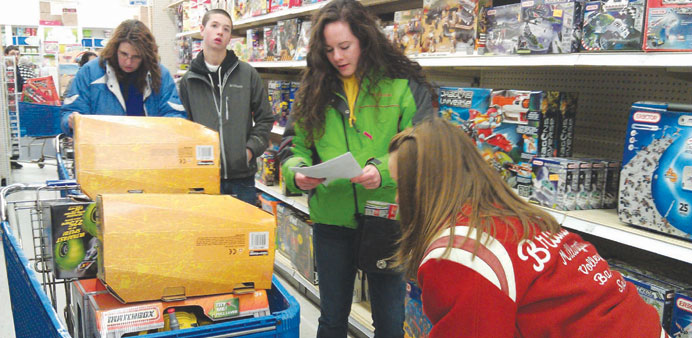Shoppers at a supermarket in New York. The Commerce Department said yesterday that consumer spending, which accounts for more than two-thirds of US economic activity, edged up 0.1% last month after dropping 0.2% in January.
Reuters/Washington
US consumer spending barely rose in February as households used the windfall from lower gasoline prices to boost savings to the highest level in more than two years, the latest sign that the economy hit a soft patch in the first quarter.
Economic growth has been undercut by bad winter weather, a strong dollar, a now-settled labour dispute at busy West Coast ports and softer demand in Europe and Asia. While the slowdown in activity is likely temporary, it could prompt the Federal Reserve to delay raising interest rates until later this year.
“We expect spending activity to rebound meaningfully in the coming months as the weather setback dissipates, but the very weak tone in the data will likely continue to temper the impulse at the Fed to tightening policy in the near-term,” said Millan Mulraine, deputy chief economist at TD Securities in New York.
The Commerce Department said yesterday that consumer spending, which accounts for more than two-thirds of US economic activity, edged up 0.1% last month after dropping 0.2% in January.
Households cut back on purchases of big-ticket items like automobiles, but a cold snap lifted spending on utilities.
Economists had forecast spending gaining 0.2%.
When adjusted for inflation, spending dipped 0.1%, the weakest reading since April of last year, after rising 0.2% in January.
Investors on Wall Street largely ignored the data, focusing attention on a raft of biotechnology merger deals. US stocks were trading higher.
The dollar gained against a basket of currencies and prices for US government debt also rose.
Consumer spending, which grew at its quickest pace in more than eight years in the fourth quarter, has lost momentum in part because of bad weather and a greater propensity by households to save money and reduce debt.
February’s soft report prompted economists to further cut their first-quarter GDP growth estimates.
Forecasting firm Macroeconomic Advisers lowered its estimate by two-tenths of a percentage point to a 0.9% annual pace. Barclays cut its forecast to a 1% rate from 1.2%, while Morgan Stanley now sees a 0.8% growth pace instead of 0.9%.
While households appear to have pocketed the bulk of their savings from lower gasoline prices or used the money to pay down debt, economists expect improved household balance sheets and a tightening labour market to boost consumer spending this year.
Income rose 0.4% last month after a similar gain in January. Savings jumped to $768.6bn, the highest level since December 2012, from $728.7bn in January.
The saving rate rose to 5.8%, also the highest since December 2012, from 5.5% in January.
“Consumers have a lot of pent-up spending power once the economy gets past the winter doldrums,” said Chris Rupkey, chief financial economist at MUFG Union Bank in New York.
There already are signs that a thaw is underway.
In a separate report, the National Association of Realtors said its Pending Home Sales Index, based on signed contracts, rose 3.1% in February to its highest level since June 2013. That indicated a pick-up in home sales.
Harsh winter weather has hurt parts of the housing sector.
There was a slight uptick in prices last month, suggesting a recent disinflationary trend had run its course, but inflation remains well below the Fed’s 2% target. Fed Chair Janet Yellen signalled on Friday that the US central bank would likely start raising interest rates later this year, even amid low-running inflation. The Fed has held its key short-term interest rate near zero since December 2008.
A price index for consumer spending increased 0.2% in February after falling 0.4% in January. In the 12 months through February, the personal consumption expenditures (PCE) price index rose 0.3%. Excluding food and energy, prices edged up 0.1% after a similar gain in January. The so-called core PCE price index increased 1.4% in the 12 months through February.
“This should reassure the Fed that recent low headline inflation readings are the result of transitory energy price declines and that inflation is likely to rise toward the Fed’s target over time,” said John Ryding, chief economist at RDQ Economics in New York.

